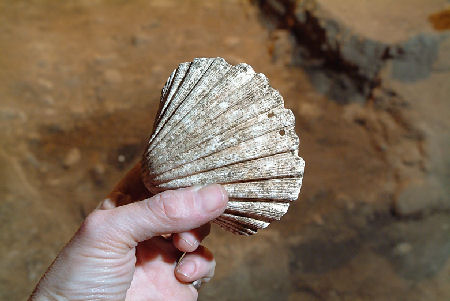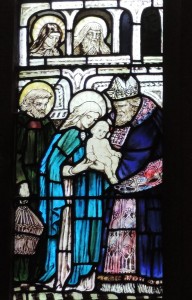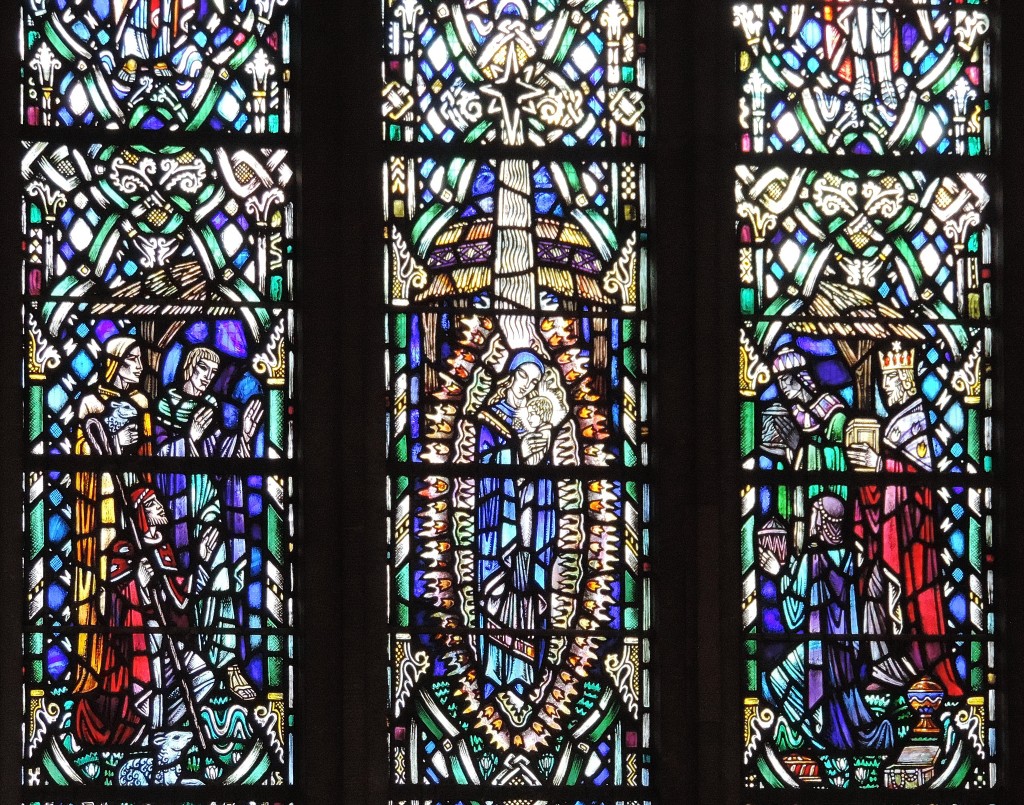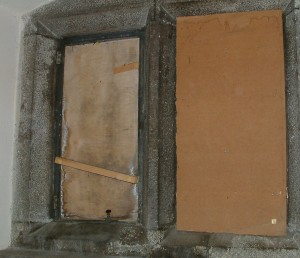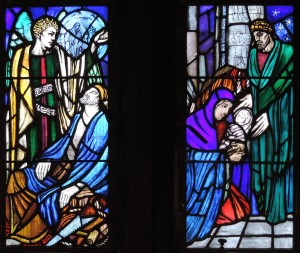St James one of Jesus’ twelve apostles died about AD 44, perhaps the first Christian martyr. Tradition says his remains were taken by boat and buried in northern Spain – in Santiago de Compestella. A Cathedral was built on the site which became a major destination for pilgrims – which it remains today. Scallop shells are commonly found on the seashore in the area. Because of some reputed miracles, they became a symbol of pilgrimage to St James’ remains. There were different routes for the pilgrimage, but the minimum walk was of 60 miles. People who completed it would acquire a scallop shell as a token. During the archaeological dig four scallop shells were found. The first one found was not with any particular burial – perhaps the actual burial had been disturbed during preparations for a later burial. The picture shows this scallop shell. The two holes drilled in the shell allowed it to be sewn onto a garment. These finds show that people from Aberdeen were making that pilgrimage to Santiago de Compestella more than 500 years ago. Quite an undertaking!
Candlemas
The birth of a baby is a time of excitement and celebration. The stories of the Birth of Jesus suggest that it must also have been a time of some anxiety for his parents – and there are always legal requirements to be met. Two thousand years ago in Israel these included a visit to the Temple in Jerusalem for the ‘purification’ of the mother and the ‘presentation’ of the child (especially the first-born male) to God. This is the event pictured in one of the windows in St Mary’s Chapel.
Mary, the mother of Jesus, is seen presenting the child to a priest in the Temple while her husband Joseph is carrying a cage with two young pigeons for the necessary sacrifice. The episode is described in chapter two of St Luke’s Gospel from which the words ‘to present him to the Lord’ are quoted under the picture. Behind the screen are Anna, an aged and very devout woman, and an old man, Simeon, with whom is associated the ancient hymn called ‘Nunc Dimittis’ (Lord, now let your servant go in peace) which is still regularly sung in many churches. A phrase from the hymn, ’a light to lighten the Gentiles’ gives rise to the name ‘Candlemas’ for the commemoration of this event 40 days after Christmas (on 2nd February).
The window was created in 1899 by Christopher Whall from London and has been described as one of the finest Arts and Crafts windows in Scotland. It was given by friends who had been associated with him in the late Victorian restoration of the Chapel in honour of Dr James Cooper and to mark his semi-jubilee as a minister, including 18 years in the East Kirk
Nativity scene in stained glass
Christmas is the time at which we celebrate the birth of Jesus. A well-known Christmas hymn puts its meaning thus: “Veiled in flesh the Godhead see”. This is central to the belief of Christians, so it is not surprising that the nativity features in many stained glass windows in churches. To start this series, we show part of the left-hand window in the apse of the former East Kirk. In the central panel, we see Mary with the baby Jesus and the star light pointing to them. In the left hand panel are the shepherds and some of their sheep whilst in the right hand panel are three kings, who had been guided by the star, bringing their gifts. All this takes place under the thatched roof of the stable. This window and the one at the opposite side of the apse were designed by Gordon Webster and installed in 1961. The son of the artist is Robin Webster who became Head of the Scott Sutherland School of Architecture. When OpenSpace is complete, this window will be part of a meeting room and so will be easy to see.
The Flight to Egypt window
How many Christmas cards have you had this year featuring the ‘three wise men’? The story of these enigmatic visitors, in St Matthew’s Gospel, is familiar. However, what follows straight afterwards in the gospel account is not mentioned so often. The story is shown in one of the windows in St Mary’s Chapel. The left hand scene is of an angel telling Joseph, shown with his carpenter’s tools, to escape with Jesus and Mary to Egypt. The right hand window shows the family in Egypt, complete with hieroglyphs in the background. Meanwhile, back in the neighbourhood of Bethlehem, Herod was slaughtering all the young boys to ensure they could not be a threat to his power.
The window was donated by Margaret Cooper, the widow of Dr Cooper who was minister of the church in 1898, the last time St Mary’s Chapel was restored. It was designed and installed by Marjorie Kemp in 1950. Unfortunately it suffered vandalism. Part of Phase 1 of the Mither Kirk Project was to repair all the glass. In this case, that was quite a challenge. One of the photographs shows the ‘window’ as it was before the work – the right hand light consisted of some bits of broken glass in a black plastic bag! The other photograph shows the window as it now is, fully restored to its original beauty.
It is a sobering to think of our world today. How many are killed so that they are not a threat? How many families have been refugees this Christmas?
St Mary’s Chapel as it is today
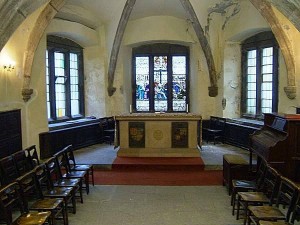 The final photograph of this series shows the Chapel more or less as it is today. By 1980, on the recommendation of George Hay, architect with the precursor of Historic Scotland, the plaster had been replaced between the stone ribs and on the walls and new lighting introduced and soft furnishings provided, giving a warmer and brighter appearance to the chapel.
The final photograph of this series shows the Chapel more or less as it is today. By 1980, on the recommendation of George Hay, architect with the precursor of Historic Scotland, the plaster had been replaced between the stone ribs and on the walls and new lighting introduced and soft furnishings provided, giving a warmer and brighter appearance to the chapel.
The photo (about 2004) also shows the result of water seepage from a leaking roof high above. As part of Phase One of the Mither Kirk Project, a new roof has been completed. This has stopped the water ingress but drying out is a slow process. In a later phase of the Mither Kirk Project the whole Chapel area will be restored.
Wooden panels of St Mary’s Chapel
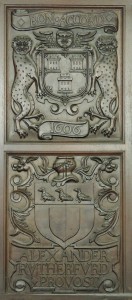 One of the many features in St Mary’s Chapel are the carved wood panels around the walls. The large screen on the west wall was originally in the Provost’s Loft in the East Kirk. The photograph shows two panels from the screen, the upper one is of the City coat of arms in 1606 and the lower one the coat of arms of the Alexander Rutherford of Rubislaw who was Provost of Aberdeen on eight other separate times between 1591 and 1615 including 1606. Clearly a good servant of the city over many years he died whilst in office in 1615.
One of the many features in St Mary’s Chapel are the carved wood panels around the walls. The large screen on the west wall was originally in the Provost’s Loft in the East Kirk. The photograph shows two panels from the screen, the upper one is of the City coat of arms in 1606 and the lower one the coat of arms of the Alexander Rutherford of Rubislaw who was Provost of Aberdeen on eight other separate times between 1591 and 1615 including 1606. Clearly a good servant of the city over many years he died whilst in office in 1615.
In 1604, another year when he was Provost, Alexander Rutherford had to put down a ‘demonstration’ by 20 boys of the Aberdeen Grammar School. Their protest was against the suppression by the Provost of their Christmas vacation, traditionally from the feast of St. Nicholas (6th December) until Innocents Day (28th December). They were armed with “hagbuttis, pistollis, swordis and lang wapynnis”. In the riot, the school boys “barred-out” their masters and magistrates and occupied the school. The siege lasted three days until hunger overtook them! The boys were taken to the Tollbooth by Provost Rutherford – but eventually the Christmas vacations were restored.
St Mary’s Chapel
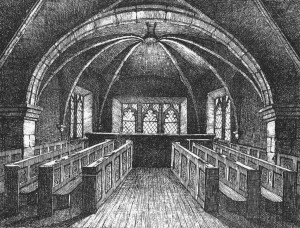 The building of St Mary’s Chapel probably began in the 1440s as the first stage of the extension of the church over the steep slope down to the Putachie Burn. When it was dedicated in 1498 St Nicholas’ was one of the largest parish churches in Scotland. After the Reformation the chapel was used for many secular purposes but by 1886 when this drawing (the earliest known view of the interior) was published it was again being used for regular services. The original window openings had been altered, a wooden floor inserted at a higher level than the original, and pews formed from carved panels removed from the church above.
The building of St Mary’s Chapel probably began in the 1440s as the first stage of the extension of the church over the steep slope down to the Putachie Burn. When it was dedicated in 1498 St Nicholas’ was one of the largest parish churches in Scotland. After the Reformation the chapel was used for many secular purposes but by 1886 when this drawing (the earliest known view of the interior) was published it was again being used for regular services. The original window openings had been altered, a wooden floor inserted at a higher level than the original, and pews formed from carved panels removed from the church above.
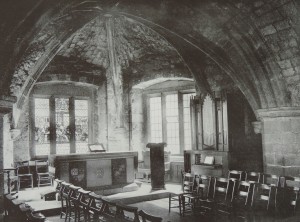 A major restoration of St Mary’s Chapel in 1898 attracted widespread public support and significantly altered its appearance. The original floor levels were restored and new floors laid in granite, in which interesting grave slabs, at one time in the church, were inserted. A stone Communion table was placed in the apse, chairs replaced the pews, and the old carved panels from these were used to form a dado round the walls while others were used along with an ancient choir desk were used to furnish a dais against the west wall. Two stained glass windows were inserted. Contrary to the architects’ recommendation, plaster between the ribs of the roof was removed, revealing some interesting, and puzzling, features.
A major restoration of St Mary’s Chapel in 1898 attracted widespread public support and significantly altered its appearance. The original floor levels were restored and new floors laid in granite, in which interesting grave slabs, at one time in the church, were inserted. A stone Communion table was placed in the apse, chairs replaced the pews, and the old carved panels from these were used to form a dado round the walls while others were used along with an ancient choir desk were used to furnish a dais against the west wall. Two stained glass windows were inserted. Contrary to the architects’ recommendation, plaster between the ribs of the roof was removed, revealing some interesting, and puzzling, features.
